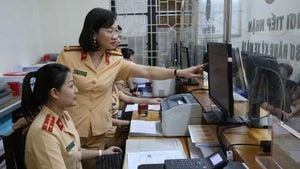Southeast Asia is gearing up to become the key focus for Trip.com’s travel expansion beginning in 2025, as discussed at the recent World Economic Forum (WEF). According to Jane Sun, the CEO of Trip.com, the region's immense growth potential has spurred the company to deepen its investments and involvement within the travel and tourism sector.
During her appearance at the WEF, Sun interacted with Kao Kim Hourn, the Secretary-General of the Association of Southeast Asian Nations (ASEAN). Their discussion revolved around collaborative strategies aimed at enhancing the travel industry through effective partnerships between private enterprises and local governments. "ASEAN is positioning itself as a premier quality tourism destination – one not only to create economic growth and jobs but also to strengthen cross-cultural connections," Kao stated, underscoring the bloc's commitment to fostering these valuable relationships.
Investments and strengthening of travel-related infrastructure have become increasingly important as the region seeks to capitalize on its tourism potential. With airport expansions and modernization projects underway, ASEAN aims to facilitate improved travel experiences for visitors. "We look forward to working with Trip.com to advance this goal," Kao added, highlighting the optimistic outlook on collaborations with industry giants.
With significant infrastructural investments on the horizon, the cooperative efforts between companies like Trip.com and ASEAN are expected to accelerate growth within the sector. The region's appeal as a top-tier travel destination hinges on the ability of stakeholders—both private and public—to navigate challenges and create favorable conditions for tourists.
Beyond the boardrooms and strategies, the cultural and culinary riches of Southeast Asia present inviting experiences for travelers. Dining at street markets—an adventure of tastes, aromas, and visuals—remains at the heart of exploring the region. Visitors can savor fresh local cuisine and exquisite flavors, from sizzling barbecued meats to unique street food delicacies. Travelers often apprehend the risks associated with trying from market vendors but can mitigate these worries by sticking to cooked or peeled foods, as well as ensuring the reliability of water sources.
Familiarizing oneself with the vibrant local food scene not only enriches the travel experience but also provides opportunities for memorable family outings. Chris Stead, who ventured through Southeast Asia, described how trying various foods—despite initial fears of illness—can lead to unforgettable moments. Discovering local eateries, engaging with friendly vendors, and sharing meals are integral parts of Southeast Asian culture.
The various street food offerings—from crispy pancakes to hot and spicy dishes—offer thrilling culinary encounters, often worth stepping outside one’s comfort zone. Stead suggests tourists should embrace food adventures and try regional specialties, citing his family's encounters with local delicacies, such as fried insects and unique flavor profiles characteristic of Southeast Asian cuisine, without facing health setbacks.
Travelers must be cautious, of course, opting for meals cooked thoroughly and ensuring hydration from safe water sources. Vendors typically utilize bottled water to wash fresh ingredients or serve cold drinks, creating sanitary options for visitors. Stead emphasizes this consciousness, advising travelers to not forego experiences but rather embrace the vibrant culinary scene with prudence.
Over the years, Southeast Asia has emerged as not only a floodgate of tourism potential but also as a cultural melting pot. The commitment of regions like ASEAN, alongside private sector players like Trip.com, emphasizes the determination to deliver rich, immersive travel experiences on the global stage. With prospects and expansions promising greater accessibility and enjoyable experiences, the future of tourism looks bright for Southeast Asia.



